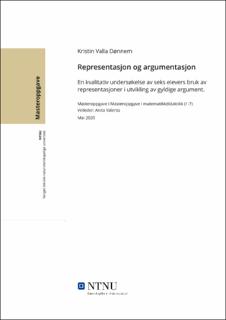| dc.contributor.advisor | Valenta, Anita | |
| dc.contributor.author | Dønnem, Kristin Valla | |
| dc.date.accessioned | 2021-09-28T17:46:15Z | |
| dc.date.available | 2021-09-28T17:46:15Z | |
| dc.date.issued | 2020 | |
| dc.identifier | no.ntnu:inspera:55578012:26299894 | |
| dc.identifier.uri | https://hdl.handle.net/11250/2784874 | |
| dc.description.abstract | I studien undersøkes elevers bruk av representasjoner i deres argumentasjon for en hypotese. Formålet med studien er å bidra til mer kunnskap rundt elevers bruk av ulike typer representasjoner når de skal utvikle gyldige argument for en generell matematisk hypotese. Studiens forskningsspørsmål er: Hvilke typer representasjoner tatt i bruk av elever i arbeid med èn generell matematisk hypotese kan fremme eller hemme utvikling av gyldige argument?
Studien er kvalitativ og består av intervju og observasjon av seks sjettetrinnselever. Elevene skulle argumentere for følgende hypotese, formulert av elevene selv: «Når man legger sammen tre påfølgende tall så vil summen alltid være i tregangen». Elevene argumenterte for hypotesen i grupper på tre og tre elever. Datamaterialet består av transkripsjoner, elevenes arbeidsark og observasjonsnotat.
For å analysere om elevenes argumentasjon var gyldig, ble det tatt utgangspunkt i A. Stylianides (2007b; 2016) sin definisjon av et bevis som et matematisk argument. Type argumentasjon ble kategorisert ut i fra G. Stylianides (2008) sin inndeling i empirisk argument, redegjørelse, generisk eksempler og generell logisk slutning. Duval (2006) sin inndeling i ulike representasjonssystemer ble brukt for å kategorisere elevenes ulike typer representasjoner brukt i studien, hvilket inkluderte muntlige forklaringer, tallsymboler og ikoniske representasjoner i form av tegninger. Elevenes tegninger ble kategorisert i strukturelle og ikke-strukturell tegninger, basert på potensialet tegningene hadde for å kunne utforske strukturer tilknyttet hypotesen. Jeg analyserte også hvordan tegning ble brukt ut i fra Stylianou (2011; 2013) sin beskrivelse av representasjoner brukt som utforskningsverktøy.
Resultatene mine viser at når elevene kun tar i bruk tallsymboler og muntlige forklaringer så kan det hemme deres utvikling av gyldige argument. Ikke-strukturelle tegninger hjalp heller ikke elevene til å utvikle gyldige argument, mens strukturelle tegninger derimot førte til gyldige argument. De strukturelle tegningene ble brukt som utforskningsverktøy hvor tegningene stadig ble endret og manipulert for å utforske strukturer og sammenhenger tilknyttet hypotesen. Ved å utforske på strukturen i tegningene, og bruke tegningene som et felles språkverktøy for å kommunisere med fellesskapet, fikk elevene mer innsikt i generaliteter tilknyttet hypotesen hvilket hjalp elevene til å utvikle gyldige argument for hypotesen. | |
| dc.description.abstract | This study investigates students’ use of representations in their argumentation for a hypothesis. The purpose of this study is to contribute to more knowledge regarding students’ use of different representations when they are developing valid arguments for a hypothesis with infinitely many cases. The research question guiding this study is: Which types of representations used by students when working with one hypothesis with infinitely many cases can promote or limit development of valid arguments?
This study has used qualitative methods such as interview and observation of two groups, each consisting of three students. The students are sixth graders between the age of 11 and 12 year olds. Following hypothesis was formulated by the students: “When three consecutive numbers are added the sum will be a multiple of three”. Their assignment was to produce valid arguments for their hypothesis. The data consists of transcriptions, the students’ worksheets and notes taken during the observation.
To analyze whether the arguments produced by the students were valid, the definition of proof as a mathematical argument (A. Stylianides, 2007b; 2016) was used. To categorize the students’ modes of argumentation, I used G. Stylianides (2008) description of empirical arguments, rationale, generic example and demonstration. Duval (2006) and different representation systems was used to identify students different modes of representations, which in this study consisted of oral explanations, number symbols and drawings. Students drawings was categorized as either structural or non-structural drawings, based on the drawings potential to explore structures in the hypothesis. I also used Stylianou’s (2011; 2013) categorization; “representations used as a exploration tool” to describe how the student used their drawings in their argumentation.
The results show that students use of only number symbols and oral explanations limited their development of valid arguments. Non-structural drawings didn’t help the students develop valid arguments either. Students’ use of structural drawings on the other hand promoted the development of valid arguments. The structural drawings were used as an exploration tool. Students used the structural drawings to make changes and manipulate them to investigate structures and contexts connected to the hypothesis further. By exploring on the drawings, and using the drawings as a common language tool to communicate with their peers, the student gained insight to the problem which helped them develop valid arguments. | |
| dc.language | | |
| dc.publisher | NTNU | |
| dc.title | Representasjon og argumentasjon | |
| dc.type | Master thesis | |
